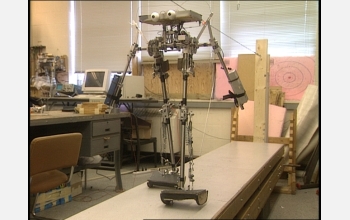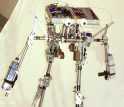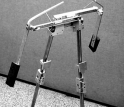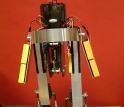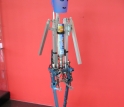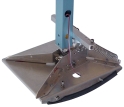News Release 05-021
Bipedal Bots Star at AAAS Media Briefing
Novel, energy frugal robots walk like we do
February 17, 2005
This material is available primarily for archival purposes. Telephone numbers or other contact information may be out of date; please see current contact information at media contacts.
At a Feb. 17 media briefing during the annual meeting of the American Association for the Advancement of Science (AAAS), members of three independent research teams jointly unveiled a new breed of powered, energy efficient, two-legged robots with a surprisingly human gait.
The new technologies are described in the Feb. 18 issue of the journal Science.
Researchers from Cornell University and the Massachusetts Institute of Technology (MIT), and their colleagues from Delft University of Technology in the Netherlands, displayed video footage of all three bipedal robots and demonstrate the biped developed at MIT.
"These innovations are a platform upon which others will build," says Michael Foster, an expert on computer and information science and engineering and one of the NSF managers who oversaw the research. "This is the foundation for what we may see in robotic control in the future."
By applying concepts rooted in "passive-dynamic walkers"—devices that can walk down a gentle slope powered only by the pull of gravity—the engineers have crafted robots like the Cornell biped that walk on level ground using one-half the wattage of a standard, compact fluorescent light bulb.
"The biped walking mechanism in robots is limited by on-board battery power," says Junku Yuh, NSF expert on intelligent systems, who also oversaw the research. "The Cornell team's passive mechanism helps greatly reduce the power requirement. Their work is very innovative."
Representing fundamental developments in computer and mechanical control, the robots are helping researchers understand bipedal motion and revealing processes that underlie human locomotion and motor learning. Applications are already on the horizon, with one researcher exploring how the new robotics can aid development of increasingly energy-efficient prosthetic devices.
"This is a perfect example of a single concept yielding benefits in a variety of fields, including medicine," says NSF program officer Gil Devey, an NSF expert on disabilities research.
The MIT walker's passive-dynamic design provides a new way to study motor learning. The robot can teach itself to walk in as little as 10 minutes, adapting to terrain as it moves.
"This project is about the fundamentals of control," says Foster. "The researchers have combined our developing knowledge of computerized control with mechanical principles that the world provides for us and shown that we can integrate the two."
All three robots verify a long-held hypothesis that suggests motors can substitute for gravity in passive-dynamic walking devices. A slope is not required, only careful engineering.
Reporters interested in attending the briefing should go to the Taft Room, Marriott Wardman Park Hotel, Washington, D.C. Please arrive no later than 9:45 am to obtain a badge for admittance. Be prepared to show a photo ID and press credentials.
A companion press release from Cornell University can be found at: http://www.news.cornell.edu/releases/Feb05/AAAS.Ruina.bipedal
.wss.html
A companion press release from MIT, and additional images, can be found at: http://web.mit.edu/newsoffice/index.html
-NSF-
-
The Cornell passive-dynamic, powered robot.
Credit and Larger Version -
A gravity driven passive-dynamic robot from Cornell.
Credit and Larger Version -
The MIT passive-dynamic powered robot.
Credit and Larger Version -
Denise, the Delft University of Technology passive-dynamic robot.
Credit and Larger Version -
Close-up view of the robot Denise's foot.
Credit and Larger Version
Co-authors for the paper, "Efficient bipedal robots based on passive-dynamic walkers," are Steve Collins, Mechanical Engineering, University of Michigan; Andy Ruina, Theoretical and Applied Mechanics, Cornell University; Russ Tedrake, Brain and Cognitive Sciences, MIT; and Martijn Wisse, Mechanical
Media Contacts
Dena Headlee, NSF, (703) 292-8070, email: dheadlee@nsf.gov
Joshua A. Chamot, NSF, (703) 292-8070, email: jchamot@nsf.gov
Bill Steele, Cornell University, (607) 255-7164, email: ws21@cornell.edu
Ginger Pinholster, AAAS/Science, (202) 326-6421, email: gpinhols@aaas.org
Elizabeth Thomson, MIT News Office, (617) 258-5402, email: thomson@mit.edu
Sherry Lassiter, NSF/MIT Center for Bits and Atoms, (617) 253-4651, email: lass@cba.mit.edu
Sonja Knols-Jacobs, Dutch Technology Foundation, STW, +15 30 6001298, email: s.knols@stw.nl
Maarten van der Sanden, Delft University of Technology, +31 15 278 5454, email: M.C.A.vanderSanden@TUDelft.NL
Program Contacts
Junku Yuh, NSF, (703) 292-8930, email: jyuh@nsf.gov
Gilbert Devey, NSF, (703) 292-7943, email: gdevey@nsf.gov
Michael J. Foster, NSF, (703) 292-8910, email: mfoster@nsf.gov
Co-Investigators
Andy Ruina, Cornell University, (607) 255-7108, email: ruina@cornell.edu
Steven Collins, University of Michigan, (734) 763-5302, email: shc@umich.edu
Russ Tedrake, Massachusetts Institute of Technology, (617) 324-4307, email: russt@ai.mi
Martijn Wisse, Delft University of Technology, +31-15-2786, email: m.wisse@wbmt.tudelft.nl
Related Websites
Andy Ruina homepage: http://tam.cornell.edu/~ruina/
NSF/MIT Center for Bits and Atoms: http://cba.mit.edu
Russ Tedrake homepage: http://hebb.mit.edu/people/russt/
Steve Collins homepage: http://www-personal.engin.umich.edu/~shc/
Martijn Wisse homepage: http://mms.tudelft.nl/dbl/Members/martijn/
The U.S. National Science Foundation propels the nation forward by advancing fundamental research in all fields of science and engineering. NSF supports research and people by providing facilities, instruments and funding to support their ingenuity and sustain the U.S. as a global leader in research and innovation. With a fiscal year 2023 budget of $9.5 billion, NSF funds reach all 50 states through grants to nearly 2,000 colleges, universities and institutions. Each year, NSF receives more than 40,000 competitive proposals and makes about 11,000 new awards. Those awards include support for cooperative research with industry, Arctic and Antarctic research and operations, and U.S. participation in international scientific efforts.
Connect with us online
NSF website: nsf.gov
NSF News: nsf.gov/news
For News Media: nsf.gov/news/newsroom
Statistics: nsf.gov/statistics/
Awards database: nsf.gov/awardsearch/
Follow us on social
Twitter: twitter.com/NSF
Facebook: facebook.com/US.NSF
Instagram: instagram.com/nsfgov

